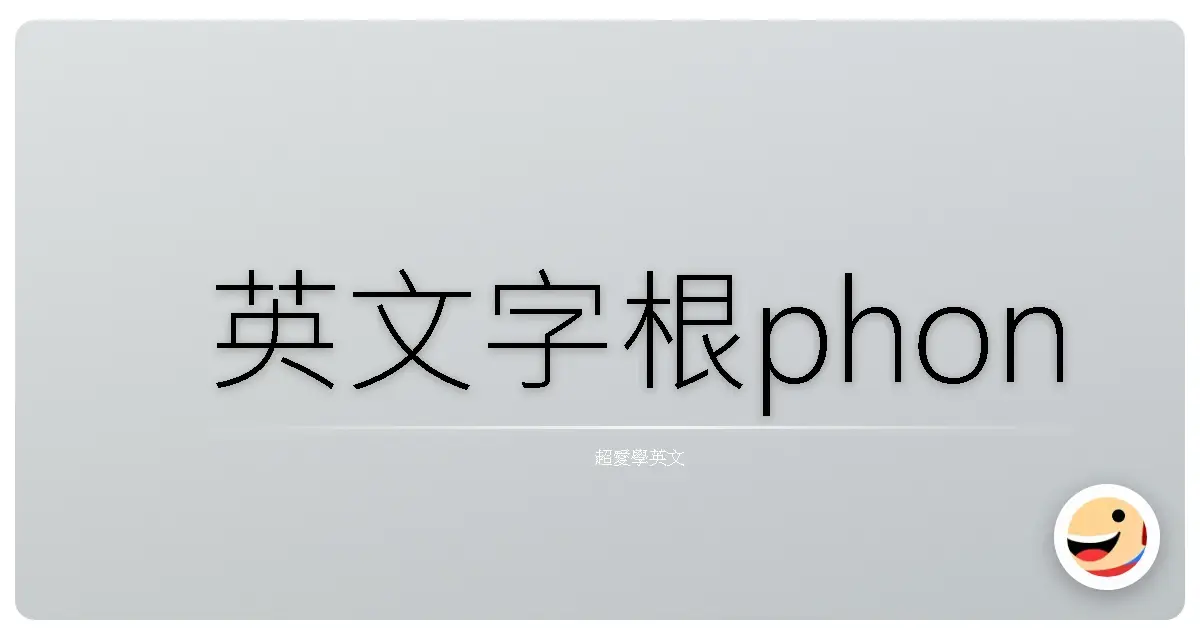
英文字根phon
「phon」這個字根來自希臘文 phōnē,意思是「聲音」。它在許多與聲音、發音、聽覺有關的英文單字中出現。我們生活中與聲音相關的行為,從說話、打電話到音樂欣賞,幾乎都藏有這個字根的影子。這些字彙不只出現在語言學中,也常見於日常生活,是非常實用的詞根之一。
1. phone(電話)
She picked up the phone and dialed her mom.
她拿起電話,撥給她媽媽。
He dropped his phone into the sink by accident.
他不小心把手機掉進水槽裡了。
The phone rang nonstop during the meeting.
會議期間電話響個不停。
→ 指能傳遞聲音的裝置,現今泛指手機或電話。
2. microphone(麥克風)
Please speak into the microphone.
請對著麥克風說話。
The microphone wasn’t working during the speech.
演講期間麥克風壞掉了。
He bought a new microphone for his podcast.
他為自己的播客買了新的麥克風。
→ micro(小)+ phon(聲音)= 收集小聲音的裝置。
3. phonics(自然發音法)
My son is learning phonics in kindergarten.
我兒子在幼稚園學自然發音法。
Phonics helps children connect letters with sounds.
自然發音法幫助孩子把字母和聲音做連結。
Teachers often use songs to teach phonics.
老師常用歌曲教發音。
→ 指教小孩認識字母發音的方法。
4. symphony(交響樂)
The symphony was absolutely breathtaking.
那場交響樂美得令人窒息。
She plays the violin in a local symphony.
她在當地交響樂團拉小提琴。
They attended a live symphony concert last weekend.
他們上週末去聽了現場交響音樂會。
→ sym(一起)+ phon(聲音)= 各種聲音合奏而成。
5. cacophony(刺耳雜音)
The city was filled with the cacophony of traffic.
城市充滿刺耳的交通噪音。
A cacophony of alarms woke everyone up.
一連串刺耳的警報聲吵醒了大家。
He covered his ears from the cacophony.
他被雜音吵得捂住耳朵。
→ caco(壞)+ phon(聲音)= 雜亂刺耳的聲音。
6. phoneme(音素)
The word “cat” has three phonemes: /k/, /æ/, and /t/.
「cat」這個字有三個音素:/k/、/æ/ 和 /t/。
Children learn phonemes before reading.
小朋友在學會閱讀前會先學音素。
Each language has its own set of phonemes.
每個語言都有自己獨特的一套音素。
→ 字的最小發音單位。
7. telephone(電話)
She answered the telephone on the first ring.
她在電話第一聲響就接起來了。
The telephone has evolved into the smartphone.
電話演變成智慧型手機。
We talked for hours on the telephone.
我們在電話上聊了好幾個小時。
→ tele(遠)+ phon(聲音)= 能傳遞遠方聲音的裝置。
8. phonograph(留聲機)
My grandfather has an old phonograph.
我祖父有台老式留聲機。
The phonograph was one of Edison’s inventions.
留聲機是愛迪生的發明之一。
They played vintage records on a phonograph.
他們在留聲機上播放老唱片。
→ graph(寫)+ phon(聲音)= 記錄聲音的裝置。
9. xylophone(木琴)
She played the xylophone in the school concert.
她在學校音樂會演奏木琴。
The toy xylophone was colorful and fun.
玩具木琴色彩繽紛又有趣。
He learned to play the xylophone as a child.
他小時候學過木琴。
→ xylo(木頭)+ phon(聲音)= 木頭發出的聲音。
10. euphony(悅耳聲音)
Her voice had a certain euphony.
她的聲音聽起來非常悅耳。
The poem’s rhythm created a natural euphony.
這首詩的韻律營造出自然的悅耳感。
Music is not just about euphony but also meaning.
音樂不只是悅耳,也包含意義。
→ eu(好)+ phon(聲音)= 好聽的聲音。
11. phonetic(語音的)
The dictionary gives the phonetic spelling.
字典提供語音拼法。
He studied the phonetic system of English.
他研究英文的語音系統。
Phonetic symbols help with pronunciation.
語音符號有助於發音。
→ 與發音相關的形容詞。
12. megaphone(擴音器)
The coach used a megaphone to give instructions.
教練用擴音器指導隊員。
She shouted through a megaphone during the protest.
她在抗議活動中用擴音器喊話。
The megaphone made his voice louder.
擴音器讓他的聲音更大。
→ mega(大)+ phon(聲音)= 放大聲音的裝置。
13. saxophone(薩克斯風)
He plays the saxophone in a jazz band.
他在爵士樂團裡吹薩克斯風。
The saxophone solo was amazing.
那段薩克斯風獨奏超棒。
She started learning the saxophone last year.
她去年開始學薩克斯風。
→ 一種吹奏樂器。
14. homophone(同音異義詞)
“Flour” and “flower” are homophones.
「flour」和「flower」是同音異義詞。
English has many homophones that confuse learners.
英文有很多讓學習者混淆的同音詞。
He made a pun using a homophone.
他用同音詞說了一個雙關語。
→ homo(相同)+ phon(聲音)= 聲音相同但意思不同的字。
15. antiphony(輪唱、應答唱)
Church music often uses antiphony.
教會音樂常使用輪唱形式。
The choir performed an antiphony with great harmony.
合唱團表演的輪唱十分和諧。
They practiced antiphony for the concert.
他們為音樂會練習輪唱。
→ anti(對應)+ phon(聲音)= 相互呼應的聲音。
16. phonology(音韻學)
He’s doing research in phonology.
他在研究音韻學。
Phonology explores sound patterns in language.
音韻學探討語言中的聲音規則。
Understanding phonology improves pronunciation.
了解音韻學有助於改善發音。
→ 語言中聲音系統的學科。
17. euphonious(悅耳的)
Her laughter was euphonious and contagious.
她的笑聲悅耳又有感染力。
The music sounded euphonious to his ears.
這音樂聽起來讓他覺得很舒服。
He preferred euphonious melodies.
他偏好聽起來順耳的旋律。
→ 描述聲音好聽的形容詞。
18. phonograph record(唱片)
He collects old phonograph records.
他收藏老式唱片。
They played jazz phonograph records at the café.
咖啡店播放爵士老唱片。
The phonograph record is making a comeback.
唱片正在復興。
→ 唱片,搭配留聲機播放的音樂媒介。
19. telephony(電話通訊技術)
He studied telephony in engineering school.
他在工程學院學電話通訊技術。
Telephony has evolved rapidly with the internet.
隨著網路,電話技術快速進步。
Modern telephony includes video calls.
現代電話通訊也包含視訊通話。
→ 指電話傳輸的技術或系統。
20. phonatory(發聲的)
The phonatory system involves the vocal cords.
發聲系統涉及聲帶運作。
Doctors checked his phonatory function.
醫生檢查了他的發聲功能。
Phonatory disorders can affect speech.
發聲障礙會影響說話。
→ 跟發聲有關的解剖或醫學用詞。
21. phonocardiogram(心音圖)
The doctor analyzed the phonocardiogram.
醫生分析心音圖。
A phonocardiogram can detect heart murmurs.
心音圖能檢測心雜音。
They recorded a phonocardiogram before surgery.
手術前他們錄下心音圖。
→ phono(聲音)+ cardio(心臟)+ gram(圖)= 心音圖。
22. phonolite(響岩)
Phonolite makes a ringing sound when struck.
敲擊響岩會發出聲音。
They studied the formation of phonolite.
他們研究響岩的形成。
Phonolite is found in some volcanic areas.
某些火山地區可見響岩。
→ 一種敲擊會有聲響的火山岩。
23. phonogram(語音符號)
Phonograms represent sounds in writing.
語音符號代表書寫中的聲音。
Ancient Egyptians used phonograms.
古埃及人使用語音符號。
A phonogram differs from a pictograph.
語音符號不同於象形文字。
→ 可表示音的圖像或符號。
24. phonocamptic(抗聲音的)
The walls are made of phonocamptic material.
牆壁用抗噪材料建成。
This phonocamptic layer reduces noise pollution.
這層抗聲材質能減少噪音污染。
Phonocamptic technologies are used in theaters.
劇院使用抗噪技術。
→ phono(聲音)+ camptic(抵抗)= 抗噪音的。
25. phonism(幻聽現象)
Patients reported phonism during episodes.
病人發作期間出現幻聽。
Phonism can be linked to mental disorders.
幻聽可能與心理疾病有關。
He was diagnosed with phonism-related symptoms.
他被診斷出有幻聽相關症狀。
→ 幻聽或虛假的聲音感知。
26. phonopathy(聲音障礙)
She was treated for phonopathy.
她接受聲音障礙治療。
Teachers often suffer from phonopathy.
老師常因講太多話而有聲音障礙。
Phonopathy may require voice therapy.
聲音障礙可能需要語音治療。
→ 與聲音疾病有關的醫學名詞。
27. polyphonic(多聲部的)
The choir sang a polyphonic piece.
合唱團演唱了一首多聲部樂曲。
He enjoys polyphonic compositions.
他喜歡多聲部的作曲。
The song had rich polyphonic textures.
這首歌有豐富的多聲部層次。
→ poly(多)+ phon(聲音)= 多聲部的。
28. phonomania(語言躁症)
His phonomania caused nonstop talking.
他的語言躁症讓他不停說話。
Phonomania can be a symptom of mania.
語言躁症可能是躁鬱症的徵狀。
The doctor noted signs of phonomania.
醫生注意到他有語言躁症的現象。
→ 無法控制地講話的病理現象。
29. phonotropism(向聲性)
Plants don’t usually exhibit phonotropism.
植物通常不會有向聲性。
Some animals show phonotropism in response to calls.
某些動物會對聲音產生向聲反應。
Phonotropism is rare in nature.
自然界中向聲性並不常見。
→ 對聲音有反應的傾向。
30. phonophobia(聲音恐懼症)
People with phonophobia avoid loud noises.
有聲音恐懼症的人會避免吵雜聲音。
Her phonophobia made concerts unbearable.
她的聲音恐懼症讓她無法忍受演唱會。
Phonophobia can be part of migraine symptoms.
聲音恐懼可能是偏頭痛的症狀之一。
→ phono(聲音)+ phobia(恐懼)= 害怕聲音的心理症狀。